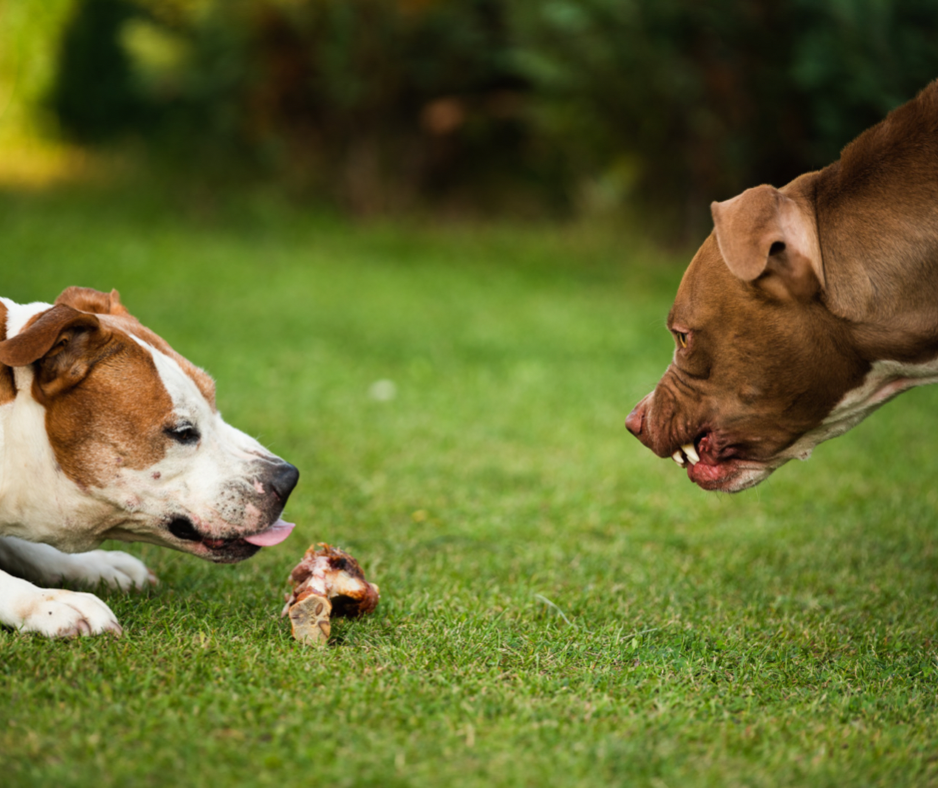Dogs are known for their loyalty and companionship, but when they exhibit resource guarding, the dynamic can become strained. Resource guarding, a common issue among canines, is an instinctual behavior where a dog aggressively defends valuable resources such as food, toys, or even their favorite spot on the couch. While the underlying reasons for resource guarding vary, understanding and addressing it effectively is crucial for safeguarding your dog’s well-being and preserving your bond.

Image: www.theconfident-k9.com
Defining Resource Guarding
Resource guarding manifests when a dog perceives something of value under threat from humans or other animals. This can range from hiding or aggressively defending specific resources to even biting to deter any perceived threat. It’s important to note that resource guarding isn’t solely an aggression problem but rather a response to a perceived scarcity of valued items.
Exploring the Root Causes
To effectively address resource guarding, it’s essential to delve into its underlying causes. Some common triggers include:
-
Fear-based anxiety: When dogs lack resources or have experienced scarcity in the past, they may develop resource guarding out of fear of losing access to essential items.
-
Learned behavior: Dogs may imitate resource guarding from their parents or previous owners, solidifying it as a learned response.
-
Medical conditions: Underlying medical issues like pain or discomfort can make dogs more prone to resource guarding.
-Genetics and Breed Traits: Certain breeds, like Terriers, may be more inclined toward resource guarding due to their territorial or protective nature.
Addressing Resource Guarding: A Step-by-Step Guide
Curbing resource guarding requires a multifaceted approach that simultaneously addresses the underlying causes and modifies your dog’s behavior. Here’s a detailed step-by-step guide to help you navigate this challenge:
-
Assess the Situation: Carefully observe your dog’s behavior around different resources to identify triggers and patterns in their guarding behavior. Note the specific items they guard, the contexts in which guarding occurs, and any signs of underlying fear or anxiety.
-
Establish a Positive Relationship: Build trust and strengthen your bond with your dog through positive reinforcement and affectionate interactions. Engage in plenty of bonding activities and reward them for calm and cooperative behaviors, creating a positive foundation for training.
-
Manage Triggers: Once you understand your dog’s triggers, gradually and systematically manage exposure to these stimuli. Start by introducing them from a distance with minimal interaction, gradually increasing proximity and intensity as your furry companion remains calm and unfazed. If your dog shows signs of guarding, immediately stop the exercise and consult with a professional trainer or veterinary behaviorist for guidance.
-
Practice Trading and Exchange: Teach your dog the “trade” or “leave it” commands. Offer your dog a high-value treat or toy in exchange for the guarded resource, rewarding them lavishly for voluntarily relinquishing it. Gradually work up to trading higher-value items, instilling in your dog that surrendering resources leads to positive outcomes.
-
Control Access to Resources: Transition to controlling access to the guarded resources. Start by randomly blocking access to these items to eliminate your dog’s perception of ownership and create a sense of unpredictability. Gradually increase the duration and frequency of blocking access, fostering security and teaching them that resources are not always readily available.
-
Use Counter-Conditioning: Counter-conditioning involves pairing the guarded resource with a positive experience. Gradually present the resource from a safe distance while simultaneously offering your dog delectable treats, creating a positive association with the resource. Over time, your dog will learn that the presence of the resource equals a rewarding experience, diminishing their guarding instinct.
Seeking Professional Help
If you’re struggling to address your dog’s resource guarding independently, don’t hesitate to enlist the assistance of a professional trainer or veterinary behaviorist. They possess expertise in canine behavior and training, enabling them to tailor a customized plan for your unique situation. Their guidance can expedite progress, ensuring the best outcome for both you and your cherished companion.
Conclusion
Remember, modifying resource guarding takes patience, consistency, and an ample dose of love. By understanding the causes, implementing these strategies, and actively managing triggers, you can effectively curb resource guarding and deepen the bond you share with your furry companion. Remember, every dog is unique, so tailor your approach to their specific needs while prioritizing their well-being and fostering a positive training environment. By adhering to these principles, you will not only restore harmony but also strengthen the bond you share with your beloved canine family member, creating a lifetime of cherished memories.

Image: peachonaleash.com
How To Fix Dog Resource Guarding